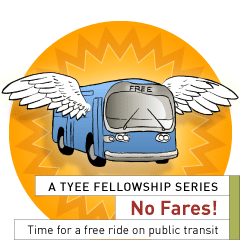Also discussed here: Campaign for free public transport leaflet (Wiganshale’s blog, Jan. 23, 2010)
Why do we expect public education, fire and police services to be “free” (or more accurately, paid for out of the public purse), but not public transit which nearly everyone sees as a basic essential public service. At the same time, road users, specifically private car drivers, expect to pay nothing for the largest item on the budget of most municipalities (road building and road maintenance) other than property taxes and a very small part of fuel taxes. The article under review today and the blogs noted that advocate free public transit make the case. A complementary action would be to use revenue from road pricing to markedly lower or eliminate transit fares, as noted in these earlier posts: Using Road Tolls to pay for Transit in Canada’s Largest City and User Based Charges for Transportation Funding

Key Quotes:
"I would have mass transit be given away for nothing and charge an awful lot for bringing an automobile into the city." (Michael Bloomberg, Mayor New York City)
“in 2000 the government subsidy to each private vehicle owner was about $5,378 in Canadian dollars. In that year, the average cost of providing each trip taken by transit in Vancouver was approximately $5. The equivalent subsidy for transit users would have been 1,075 free trips’
“Revenue for any system drops when ridership dips or when fares are increased.. the Simpson-Curtain rule.. It drops 3.8 per cent for every 10 per cent increase in fares, researchers have found.”
“public transport .. an essential public service, and as such, like health and education, should be paid for out of general taxation.”
“72% of people interviewed in a recent survey said they would not give up their car until they could use public transport without charge (UK survey)”
Some of the 17 benefits listed in the Kyee Blog:
- “eliminating a "toll" from a mode of transportation that we as a society want to be used
- reducing the inequity between the subsidies given to private motorized vehicle users and public transport users
- reducing, and in some cases eliminating, the need for private motorized vehicle parking
- reducing greenhouse gas emissions, other air pollutants, noise pollution, and run-off of toxic chemicals into fresh water supplies and ocean environments
- reducing overall consumption of oil and gasoline
- eliminating the perceived need to spend billions on roads and highways
- eliminating the perceived need to spend billions on bigger car-carrying ferries
- allowing all bus doors to be used to load passengers, making service faster and more efficient”
Related articles by Zemanta
- What Solves Congestion? (seattletransitblog.com)
- Bus cuts drive Americans back to cars | Sasha Abramsky (guardian.co.uk)
- New York Subway Getting Wired (thecityfix.com)
- The Social Inequality of Public Transit (accessible-transportation.suite101.com)
- Alex Pasternack: Can We Build Transit Systems With Our Phones? Weeels Says Yes (huffingtonpost.com)
- John Robbins: What Ever Happened to Public Transportation? (huffingtonpost.com)

No comments:
Post a Comment